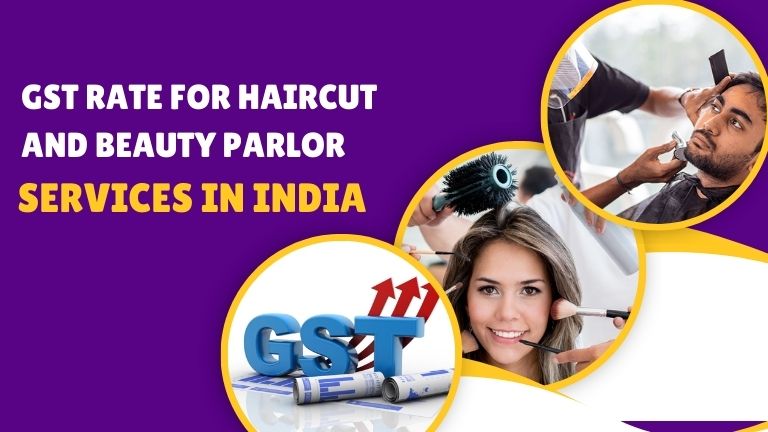The Goods and
Services Tax (GST) has significantly impacted various sectors in India, and the
beauty and wellness industry is no exception. For businesses like hair salons
and beauty parlors, understanding the applicable GST rates is crucial for
compliance and accurate pricing. This article delves into the specifics of GST
rates for haircut and beauty parlor services, providing clarity on how these
businesses operate under the current GST framework.
What
Services Fall Under the Beauty Parlor Umbrella?
Before we jump into
the GST rates, it's important to define what constitutes "beauty parlor
services." This category encompasses a wide range of offerings, including:
- Haircuts & Styling: Cutting, trimming, styling, coloring,
perming, and hair treatments.
- Facials & Skin Care: Facials, clean-ups, massages, and
various skin treatments.
- Makeup Services: Bridal makeup, party makeup, and
everyday makeup applications.
- Manicures & Pedicures: Nail care, filing, polishing, and
related treatments.
- Waxing & Threading: Hair removal services.
- Body Treatments: Massages, body wraps, and scrubs.
- Other Services: Henna application, ear piercing, and other similar services.
The
Applicable GST Rate on Haircut and Beauty Services
Under the GST
regime, services provided by beauty parlors, including haircuts and other
beauty treatments, fall under the Service Code 9997
(Other Personal Services). The current GST rate applicable to these services
is 18%.
This means that any
beauty parlor or hair salon providing the above-mentioned services needs to
charge an 18% GST on their service charges. This rate applies across the board,
regardless of the size or location of the establishment.
Why
is it 18% GST?
The 18% GST rate is
considered a standard rate for most services in India. The government aims to
simplify tax compliance by having clearly defined rates for various service
sectors. The beauty and wellness industry, being a significant contributor to
the service sector, is subject to this standard rate.
Understanding
Different Scenarios
While the GST rate
is a uniform 18%, businesses need to consider a few scenarios:
- Composition Scheme: Small businesses with an annual turnover
below a certain threshold (currently INR 1.5 crore) can opt for the
composition scheme. Under this scheme, they pay a lower rate of GST but
cannot claim Input Tax Credit (ITC). This might be beneficial for some
smaller salons and parlors. However, it's essential to weigh the pros and
cons carefully, as they cannot pass on the ITC benefit to customers.
- Purchase of Goods (Products): Beauty parlors also
purchase products like shampoos, conditioners, creams, and makeup. These
products are usually subject to a separate GST rate (usually 5%, 12%, 18%,
or 28%) depending on
the specific product. The GST rate applicable to these goods is based on the HSN
(Harmonized System of Nomenclature) code of the product.
- Bundled Services: Some parlors offer bundled packages or
memberships. The GST rate in this case will still be 18% on the overall
service charge, even if the package includes several different types of
services.
How
GST Affects Pricing for Haircuts and Beauty Services
The implementation
of GST has directly influenced the pricing structure of beauty parlors. Earlier,
service tax and other state-level taxes were applicable to these services. Now,
with a uniform 18% GST rate, businesses have to adjust their pricing
accordingly.
Here's a simplified
breakdown:
1. Service
Cost: The
basic cost of the service (e.g., haircut, facial)
2. GST
at 18%: 18%
of the service cost is added as GST.
3. Total
Price: The
sum of the service cost and the GST.
For example:
- If a
haircut costs INR 500, the GST at 18% will be INR 90.
- The
total price for the haircut will be INR 590.
Importance
of GST Compliance
For businesses in
the beauty industry, GST compliance is paramount. This involves:
- Proper Registration: Obtaining a GST registration if turnover
exceeds the prescribed threshold.
- Accurate Invoicing: Issuing GST-compliant invoices.
- Filing Returns: Filing regular GST returns (GSTR-1, GSTR-3B).
- Claiming Input Tax Credit (ITC): If eligible, claiming
ITC on purchases.
- Maintaining Records: Keeping precise records of all
transactions.
Non-compliance can
lead to penalties and legal complications. Therefore, beauty parlor owners must
ensure they are well-versed in the GST regulations and maintain proper
accounting practices.
The
Impact of GST on the Beauty Industry
The GST regime has
brought both challenges and opportunities to the beauty industry:
- Challenges: Initial adjustments to pricing, learning new accounting
procedures, increased documentation requirements.
- Opportunities: Streamlined taxation, ease of doing business, reduced chances
of tax evasion, increased transparency.
Key
Takeaways
- The GST
rate applicable to haircut and beauty parlor services is 18%.
- This
rate is applicable on the service charges of various offerings like
haircuts, facials, makeup, and other treatments.
- Small
businesses can opt for the composition scheme, but they cannot claim ITC.
- GST
compliance is crucial for beauty parlors to avoid penalties.
- Understanding
the GST framework allows businesses to operate effectively and maintain
financial health.
Conclusion
The implementation
of GST has streamlined taxation for businesses across the beauty and wellness
sector. While adapting to the 18% GST rate on haircut and beauty services
requires a clear understanding of the GST laws, it contributes significantly to
a more organized and transparent business environment. By staying compliant and
maintaining diligent financial practices, beauty parlors can thrive in the
evolving economic landscape.
ALSO READ-

